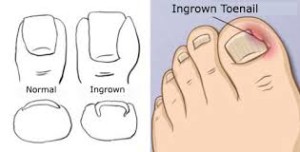Ingrown Toenails
An ingrown toenail is curved and grows into the skin. This digging in of the nail irritates the skin, often creating pain, redness, swelling and warmth in the toe. If an ingrown nail causes a break in the skin, bacteria may enter and cause an infection in the area, which often causes drainage and a foul odor. However, even if the toe is not painful, red, swollen or warm, a nail that curves downward into the skin can progress to an infection.

Causes
Causes of ingrown toenails include:
• Heredity
• Trauma
• Improper trimming
• Too tight or too small footwear
• Nail conditions such as fungal infections or regrowth of a toenail that has fallen off.
Treatment
Sometimes, initial treatment for ingrown toenails can be safely performed at home. If an infection is suspected or for those who have medical conditions, such as diabetes, nerve damage in the foot or poor circulation, home treatment is strongly discouraged
Home Care
If you do not have an infection or any of the above medical conditions, you can soak your foot in room-temperature water and gently massage the side of the nail fold to help reduce the inflammation. However, avoid attempting “bathroom surgery.” Repeated cutting of the nail can cause the condition to worsen over time. If your symptoms fail to improve, it is time to schedule an appointment.
Ingrown Toenail Office Procedure
After the examination, a minor surgical procedure is performed in the office to ease the pain and remove the offending portion of the nail. The procedure begins by applying a local anesthetic. After that, the doctor removes part of the nail’s side border and the nail root. Following the procedure, a light bandage is applied and patients receive care instruction for the next two weeks. Most people experience very little pain after surgery and resume normal activity the next day. If an infection is present, an oral antibiotic may be prescribed.
What You Should Know About Home Treatment
• Do not cut a notch in the nail. This does not reduce the tendency for the nail to curve downward.
• Do not repeatedly trim nail borders. It can make the condition worse.
• Do not place cotton under the nail. Not only does this not relieve the pain it also provides a place for harmful bacteria to grow, resulting in infection.
• Over-the-counter medications are ineffective. Topical medications may mask the pain, but they do not correct the underlying problem.






Call Us Today: 402.315.4406